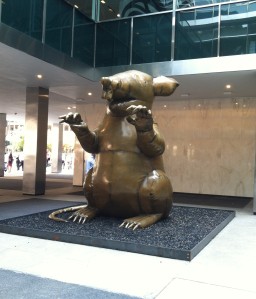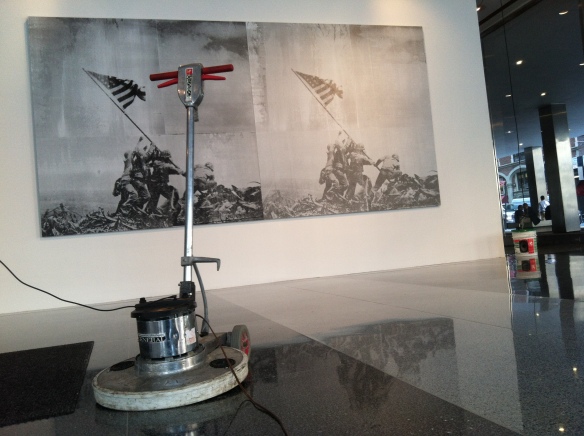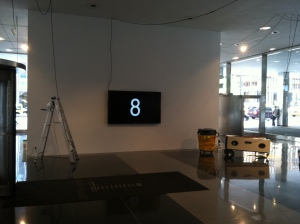BHQF @ Lever House
 I veer off a bustling Park Ave sidewalk and into the Lever House plaza where office workers cluster in small groups eating sandwiches and sipping canned drinks. Others smoke and watch the screens on their phones. It’s mid afternoon and none seem aware of the big bronze rat perched on its haunches, claws extended as if poised to enter the south entrance of the Lever House. This twelve-foot sculpture is a 1:1 replica of the inflatable rat that pissed off union workers erect outside the buildings of employers they’re protesting. As I pick up a scrap of what looks like shredded tire from the work’s base, I can’t help wondering if the artists employed nonunion labor to do the fabrication and if that wouldn’t be like commissioning an atheist to paint the Last Supper.
I veer off a bustling Park Ave sidewalk and into the Lever House plaza where office workers cluster in small groups eating sandwiches and sipping canned drinks. Others smoke and watch the screens on their phones. It’s mid afternoon and none seem aware of the big bronze rat perched on its haunches, claws extended as if poised to enter the south entrance of the Lever House. This twelve-foot sculpture is a 1:1 replica of the inflatable rat that pissed off union workers erect outside the buildings of employers they’re protesting. As I pick up a scrap of what looks like shredded tire from the work’s base, I can’t help wondering if the artists employed nonunion labor to do the fabrication and if that wouldn’t be like commissioning an atheist to paint the Last Supper.
Two men in blue suits carrying briefcases enter the revolving door ahead of me and all three of us take a moment to look at the two silver screen prints of the flag raising at Iwo Jima. It’s cool in the lobby, well air-conditioned. One suit says to the other, “you know this was a staged photo, right?” “Yeah,” replies the other, “but it doesn’t really matter how it was made does it? Isn’t what’s important the message of teamwork and victory and patriotism that the image conveys?” Suit one pivots to face his colleague, “you know,” he says, “you should have been in advertising.”
As they go clopping off across the linoleum floor toward the elevator bank I lean against the lobby’s glass wall and wonder why I care about who made what? Outsourcing labor is standard protocol in the art world; nobody flinches at the practice anymore. But in the context of labor unions—organizations that indeed care deeply about who does what job—is the act of outsourcing production more significant? Can an artist borrow the symbolism of a group while simultaneously disregarding the principles that the group stands for? And wouldn’t such an act essentially deplete the inherent meaning of the symbol? Well, perhaps. But I don’t think that’s the issue here. The bronze rat is no more about protest than the screen prints of the flag raising are about patriotism. They’re simulacrums of symbols that refer as much to Warhol’s legacy as to the maxims of soldiers or union workers.
 All the while I’ve been in here I’ve been distracted by the sound of numbers being shouted in a kind of call and response pattern that reminds me of Occupy Wall Street’s human microphone. The cacophony is coming from speakers installed in pieces of office and janitorial equipment scattered throughout the lobby in a lingering way that makes them look left behind. These aren’t representations of the things but the things themselves: a ladder, a mop bucket, an electric floor polisher, to name only a few. Their wiring is exposed, running to outlets in the floor and arcing like power lines across the ceiling to a central point that happens to be an industrial vacuum cleaner. I follow the black cords and quickly learn that the numbers, which are counting upwards, correspond to the video on the flat screen. Standing beside the vacuum I can also hear that the video has its own soundtrack humming faintly from a dustpan.
All the while I’ve been in here I’ve been distracted by the sound of numbers being shouted in a kind of call and response pattern that reminds me of Occupy Wall Street’s human microphone. The cacophony is coming from speakers installed in pieces of office and janitorial equipment scattered throughout the lobby in a lingering way that makes them look left behind. These aren’t representations of the things but the things themselves: a ladder, a mop bucket, an electric floor polisher, to name only a few. Their wiring is exposed, running to outlets in the floor and arcing like power lines across the ceiling to a central point that happens to be an industrial vacuum cleaner. I follow the black cords and quickly learn that the numbers, which are counting upwards, correspond to the video on the flat screen. Standing beside the vacuum I can also hear that the video has its own soundtrack humming faintly from a dustpan.
I watch clips of Che Guevera, Dylan, Koons, Angela Davis, and marching Occupy protestors while straining to hear what’s being said or sang. Much I can’t make out though I know I hear a snippet of Dylan’s “With God on our Side,” and I laugh out loud at number 95: a clip of Martin Luther nailing his theses to the church door while Jay-Z’s hit single, “99 Problems,” quietly thumps along. I don’t think a bitch was one of Luther’s problems either.
Of the twelve objects there is one with an added feature; the filing cabinet is equipped with a glowing red light. It’s set on its side with one drawer open exposing the bulb and seeming to spill documents. I crouch down, and with Luther on my mind I get to thinking about the twelve objects in relation to Christ’s apostles. Does the spill signify an information leak? Is the file cabinet Judas? The documents are all the same. They list 95 quotes that relate to the video. I shout to the guard across the lobby, asking if I can take one. He doesn’t know.
As I pass back through the revolving doors I have to admit that the artwork appeals to the puzzle-solver part of my personality, the bit of me that relishes the cleverness in what often seems to others as vapid exercises in socio-cultural cross-referencing. Being clever alone isn’t enough though because once the puzzle is solved it ceases to be relevant or interesting or even slightly enticing. On my way past the bronze rat I step onto its base and give it a stroke. “You know rat,” I say running a hand along the underside of its metal paw, “everything in this exhibition seems to be about sincerity and urgency without anything being sincere or urgent itself.” The rat doesn’t respond, of course, but the guard does in incredibly lively manner.


